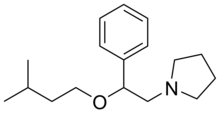Amixetrine
 | |
| Clinical data | |
|---|---|
| Routes of administration | Oral |
| ATC code |
|
| Legal status | |
| Legal status |
|
| Identifiers | |
| |
| CAS Number | |
| PubChem CID | |
| ChemSpider | |
| UNII | |
| ChEMBL | |
| Chemical and physical data | |
| Formula | C17H27NO |
| Molar mass | 261.409 g·mol−1 |
| 3D model (JSmol) | |
| |
| |
| | |
Amixetrine (INN) (brand name Somagest; developmental code name CERM-898) is a drug that was formerly marketed in France but is now no longer sold.[1][2] According to various sources it has been said to be an anti-inflammatory, antidepressant, antispasmodic, anticholinergic, antihistamine, and antiserotonergic, but its definitive indications and pharmacology are unclear.[1][2] The drug was first synthesized in 1969 and was introduced in France in 1972.[1][2]
References[]
- ^ a b c Elks J (14 November 2014). The Dictionary of Drugs: Chemical Data: Chemical Data, Structures and Bibliographies. Springer. pp. 80–. ISBN 978-1-4757-2085-3.
- ^ a b c William Andrew Publishing (22 October 2013). "Amixetrine Hydrochloride". Pharmaceutical Manufacturing Encyclopedia (3rd ed.). Elsevier. pp. 285–. ISBN 978-0-8155-1856-3.
Categories:
- Drugs not assigned an ATC code
- Abandoned drugs
- Anti-inflammatory agents
- Antidepressants
- Antispasmodics
- Drugs with unknown mechanisms of action
- Ethers
- Pyrrolidines
- Musculoskeletal system drug stubs